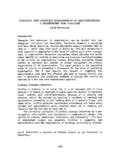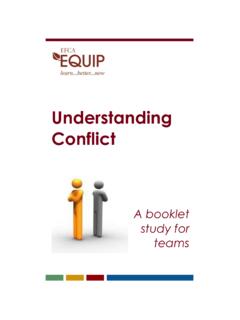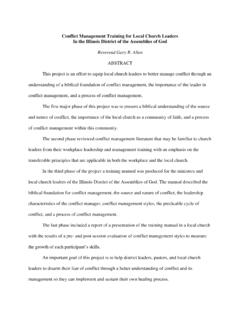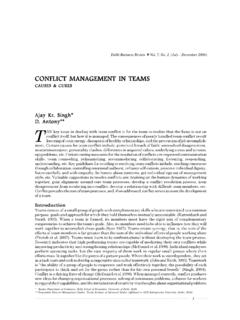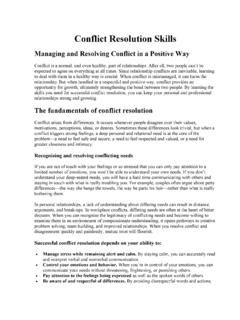Transcription of Conflict Management Styles in the Classroom - …
1 Academic Exchange Quarterly F a l l 2013 ISSN 1096-1453 Volume 17, Issue 3 To cite, use print source rather than this on-line version which may not reflect print copy format requirements or text lay-out and pagination. This article should not be reprinted for inclusion in any publication for sale without author's explicit permission. Anyone ma y view, reproduce or store copy of this article for personal, non-commercial use as allowed by the "Fair Use" limitations (sections 107 and 108) of the Copyright law. For any other use and for reprints, contact article's author(s) who may impose usage f e e.. See also electronic version copyright clearance CURRENT VERSION COPYRIGHT MMXIII AUTHOR & ACADEM IC EXCHANGE QUARTERLY Conflict Management Styles in the Classroom Stephen A. Furlich, Texas A&M University-Commerce, TX Derek C.
2 Clapp, McLennan Community College, TX Stephen A. Furlich, is an Assistant Professor Department of Mass Media, Communication, Theatre, and Derek C. Clapp, is an Associate Professor in the Department of Communication Studies. Abstract The present study deviates from previous research by investigating personality and immediacy interactions w i t h Conflict Management Styles within small groups inside the Classroom . Categories of personality were used. Results showed robust and statistically significant c o r r e l a t i o ns for some o f t he Conflict Management Styles with immediacy and personality. Implications from the results are discussed in the paper as to the usefulness of predicting s ma l l group member s Conflict style within the Classroom . Introduction Conflict is inevitable and it often becomes a vital component of group proje ct s ( Alino & Schneider, 2012).
3 In order for Conflict to be a positive force within a s m a l l group, a better understanding of Conflict must be sought. Therefore, this paper will investigate individual s Conflict Management Styles inside small groups within the Classroom through the variables of immediacy and personality. Johnson and Johnson (2012) define Conflict as communication interactions between two or more interdependent people who have separate goals. B lake and Mouton s (1964) Conflict managerial grid identifies specific Conflict Styles one may exhibit. The five Styles of Conflict Management are accommodating, avoiding, competing, collaborating, and compromising. Blake and Mouton (1964) o ffe r a hu ma n relations perspective on managing Conflict by e mp ha s izing interpersonal and small group behaviors (Sharma, 2012).
4 Consequently the researchers believe that studying t he variables im med ia c y and personality within small groups inside the Classroom for this study are germane to further understanding Conflict issues. Rationale and Research Question E m p l o y e e s are finding themselves spending time in small groups within organizations more t ha n e ve r be fo r e. These small groups can be assembled for various reasons such as decision-making and problem-solving (Bonebright, 2010). Therefore, with small groups playing a larger role within organizations, educators within higher education need to better understand d yna m ic s within Classroom small groups that prepare students for work life. S m a l l group Conflict inside the Classroom must be studied in order to further understand the constructive and destructive potential of intragroup Conflict .
5 Conflict Management st yle s ha ve been found to influence the outcome of Conflict resolutions (Gelfand, Keller, Leslie, & de Dreu, 2012). However, it s imp act ha s no t be e n adequately addressed when involved with immediacy and personality. Immed iac y has not been addressed in the area of small group Conflict within the Classroom . However, immediacy has been shown to have an impact on behaviors and communication outcomes in the instructional context (Sidelinger, 2010; Witt & Kerssen-Griep, 2011). I mmed iac y has been previously defined from an instructor s perspective as use of pro-s o c i a l a s opposed to antisocial messages to alter student behavior (Gorham, 1988, p. 41). I mmed iac y is defined in this study as a student who displays pro-s o c i a l as opposed to antisocial messages in a small group within the Classroom .
6 Finally, personality has been shown to influence behaviors such as Conflict resolution (Ward, Atkins, Lepper, & Ross, 2011). However, personality has not been addressed in relation to i m med iac y w it h Conflict resolution Styles . Personality is defined in this paper as a consistent set of behaviors that an individual exhibits. The interactions between Conflict Management Styles , immediacy, and personality can further under st a nding small group Conflict within the Classroom . T he r e fore, the following research question is proposed: RQ1: Do relationships exist between Conflict Management Styles , pe r s o n a l i t y st yles, and im med iac y in small groups within the Classroom ? Conflict Styles Conflict appropriateness and effectiveness are often constant issues found within Conflict .
7 They play an important role when studying Conflict . However, the structure of Conflict can make these two constructs a difficult challenge to balance (Romer, Rispens, Giebels, & Euwema, 2012). O ne w a y t o understand differing Conflict Management Styles is through Blake and Mouton s (1964) Conflict managerial grid, which encompasses five key conflic t ma na g e me nt st yle s. T he se include accommodating, avoiding, competing, collaborating and compromising. Conflict Styles within Classroom s m a l l groups can impact the interactions within the groups, as well as the group out c o m e s. Conflict Styles can become predictive of the individual s communication strategies (Vecchi, 2009). Therefore, it would be beneficial for one to be able to project an individual s likely Conflict Management style in order to place the right person in a given situat i o n.
8 Immediacy Much of the previous immediacy research has been conducted in the instructional context. Inferences can be drawn from this r e se a r c h in t he instructional context to predict Conflict Management Styles in groups based upon personality. An individual student s c o ns ist e nt i m med iacy behaviors within a small group are aligne d with our definition of personality as a consistent set of behaviors. This study hopes to increase understanding the Conflict Management st yle an individual is likely to use with immediacy and personality. Scholars have addressed the influential effects of immediacy over the past three decades (Pogue, & Ahyun, 2007). Mehrabian (1966) is often credited with initially addressing immediacy as an influential component in forming attitudes from communication interactions.
9 Mehrabian (1966) found that less immediate communication was associated with more negative communication assessments. Immediacy has been found to be influential with students inside the Classroom (Sidelinger, 2010; Witt & Kerssen-Griep, 2011). This is important to understand because people do have some control over the impact t ha t t he ir im me d ia c y be haviors have with others they interact with (Harrison, 2011; Lapka, 2012; Sidelinger, 2010; Zeng & Zhang, 2012). Gorham (1988) identified some of the ve r ba l i m me d ia c y behaviors found to be important to students learning, including the use of humor, praising students, engaging in conversations with students before, after, or outside of class, teachers self-disclosure, encouraging students to talk, and asking for students input.
10 Instructors tend to continually display the same immediacy behaviors and have the same consistent impact on their students (Darjan, 2011), therefore students within small groups are likely to display the same Conflict Management style behaviors because it is part of their personality a s i s i m med ia c y. Personality Styles Another variable that may impact the Conflict situation is personality. A common means by which researchers study personality and Conflict is the five-factor structure. The Big Five factors of personality are ext r ove r s io n, agreeableness, conscientiousness, emotional stability, and openness to experience (Gurven, Von Rueden, Massenkoff, Kaplan, & Lero Vie, 2013). Tupes and Christal (1961) initially generated the Big Five model and was later built upon by Goldberg (1990).




